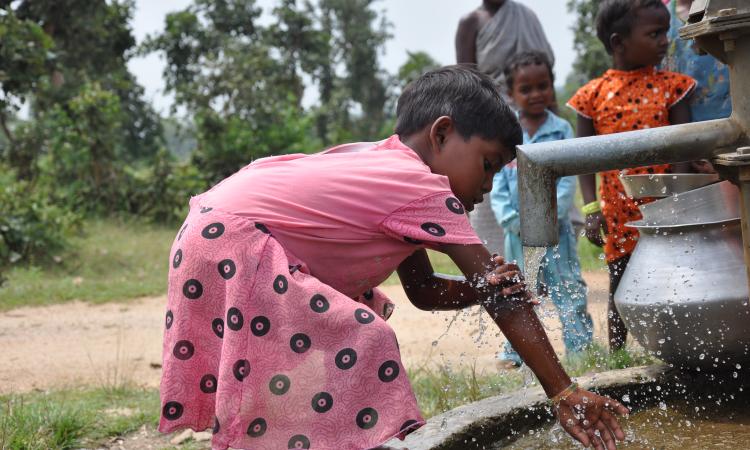
Convened to mark the successful conclusion of the Women+Water Alliance project in select districts of Madhya Pradesh and Maharashtra, U.S. Agency for International Development (USAID), Gap Inc., and Alliance partners, including WaterAid India organised a workshop on 12th December 2022 in Delhi. The successful partnership aimed to empower women and mobilise communities to serve as change agents for advancing WASH practices.
Implemented by WaterAid India, and other organizations including CARE International, WaterAid India, Water.org, and Institute for Sustainable Communities (ISC), Women+Water is a six-year (2017-2022) Global Development Alliance between USAID and Gap Inc. The Alliance is committed to improving and sustaining the health and well-being of women and communities touched by the apparel industry in India.
Since 2019, The Women + Water Alliance, supported by USAID and Gap Inc. has empowered women and mobilised communities to serve as change agents for advancing WASH practices in select districts of Madhya Pradesh & Maharashtra.
Welcoming all partners and guests, Judy Adler, Vice President, Global Sustainability & ESG, Gap Inc. and President, Gap Foundation said “Gap Inc. is focused on water conservation and women empowerment, creating water champions in the communities and building water resilience. We believe that availability of water is a human right and is a critical natural resource not only for the health and well-being of our community, but also to carry out business activities.”
Shedding light on WaterAid India’s role in the W+W Alliance, VK Madhavan, Chief Executive, WaterAid India said the focus was on enabling equitable and inclusive access of clean water to people at all levels. He further added, “The Alliance has given us the opportunity to work with other civil society organisations, driving collective impact and attain the scale that matters. We have been facilitating the creation of village action plans by community members, in establishing community-led water quality monitoring & surveillance, grooming women leaders; and in building the capacity of local village-level institutions”.
Proceeding with the workshop, Ella Lazarte, Senior Water and Sanitation Advisor, USAID shared how the programme was instrumental in achieving three things- “Conscious collaboration between all stakeholders including communities, private sector and Government; creating women leaders and supporting them to advocate for clean water and sanitation; and strengthening institutions to usher transformational change in the society."
Strengthening the Jal Jeevan Mission (JJM), WaterAid India implemented the programme while adhering to the guidelines of JJM and worked in collaboration with the local administration in Madhya Pradesh and Maharashtra. A key priority of this partnership is to bolster community-level activities and women’s leadership by providing handholding support to Village Water & Sanitation Committees & Panchayati Raj Institution members. The project ensured putting systems and processes in place to ensure equitable distribution of drinking water to all households and plan for the sustainability of the piped water supply schemes in a participatory and transparent manner.
The project successfully reached and benefited over 7 districts with 40 blocks and 2400 villages and prioritised key interventions like advancing WASH practices in communities via women leadership, strengthening the system by building capacity, community-led water quality monitoring & surveillance and planning. Furthermore, the alliance focused on helping the community understand concepts and translate knowledge into action, effectively grooming the community to lead and sustain the scheme after the intervention.
Key highlights of the project
- Supported the department in developing community-led Village Action Plans (VAPs) in 2,297 villages. Of the 2,297 VAPs developed, 2057 VAPs were approved by the department.
- 13,799 of women & youth have been trained on the use of field testing kits to strengthen water quality monitoring & surveillance.
- 3,541 of Village Water & Sanitation Committee (VWSC) members have been trained on institutional, technical, and financial aspects of the operation & maintenance of Pipe Water Supply Schemes (PWSS).
- In addition to this, 3,089 of Panchayati Raj Institution (PRI) members were trained on management of piped water supply schemes (PWSSs), convergence, and water security, 2,037 women were trained to increase their leadership on water-related activities in the village and to increase their active participation in Gram Sabhas.
- 991 villages have started water tariff collection and lastly, about 185 individuals have been trained at the village level as pump operators to support operation and maintenance.
Other prominent partner organisations that were at the forefront of this intervention program, present at the event included Samarthan (Sehore, Indore, Khandwa), Centre for Advanced Research & Development - CARD (Dhar and Dewas), and National Institute for Women Child and Youth.
About WaterAid India
WaterAid India is a not-for-profit organisation and part of the global WaterAid network which seeks to improve access to clean water, decent toilets and good hygiene for everyone, everywhere. Since 1986, WaterAid India has successfully implemented water, sanitation, and hygiene projects to transform the lives of the poor and the most marginalised. In India, WaterAid is present in 13 states and 45 districts/cities/towns. Over the years, WaterAid India has evolved as an organisation and is working with the help of various stakeholders towards addressing people’s basic needs. In 2021-22 alone, WaterAid India had reached 6,31,539 people with access to clean and safe drinking water, and 3,70,673 people with access to decent toilets.